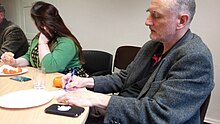Sebastian Rahtz
aus Wikipedia, der freien Enzyklopädie

Sebastian Patrick Quintus Rahtz, SPQR, (geboren am 13. Februar 1955 in Bristol; gestorben am 15. März 2016 in Oxford) war ein britischer Informatiker auf dem Feld der Digital Humanities und Lexikograph.
Leben
[Bearbeiten | Quelltext bearbeiten]Sebastian Rahtz, fünftes Kind (Quintus) des auf Somerset und Umgebung spezialisierten Archäologen Philip Rahtz (1921–2011), studierte Classics und Neugriechisch an der Universität Oxford und machte seinen Master of Arts in Archäologie 1981 an der Universität London. Thema seiner Masterarbeit war Funerary Epitaphs and Iconography: An Analysis of the Protestant Cemetery, eine Arbeit über den Protestantischen Friedhof in Rom.[1]
Nachdem er einige Jahre als Archäologe gearbeitet hatte, wandte er sich der EDV zu und wurde in den frühen 1980er-Jahren Lecturer für Humanities computing an der Universität Southampton, wo der Informatiker David W. Barron (1935–2012) lehrte. Über ihn kam Sebastian Rahtz erstmals in Kontakt mit dem Textsatzsystem TeX. Für die nächsten Jahrzehnte wurde er wichtiges Mitglied verschiedener Initiativen im Bereich der Digital Humanities, war 1996 Begründer des Projektes TeX Live und einer der Pioniere in der Text Encoding Initiative (TEI). Für TEI leistete er wichtige Beiträge bei Aufbau und Wartung eines Großteils der technischen Infrastruktur und der zugehörigen Software, wie etwa deren XSLT-Stylesheets und die webbasierte Konvertierungs-Engine OxGarage,[2] CLAROS,[3] das Oxford Text Archive,[4] die Text Creation Partnership[5] und OSS Watch,[6] einen vom Joint Information Systems Committee finanzierten nationalen Beratungsdienst für Open-Source-Software. Im Jahr 1982 kam er zum Team des Lexicon of Greek Personal Names (LGPN) an der Universität Oxford und unterstützte Elaine Matthews bei der Konvertierung der LGPN-Datenbank in eine XML-Datenbank. Die Umstellung war Grundlage der aktuellen Online-Datenbanksuche und von grundlegender Bedeutung für die langfristige Wartung und den Austausch der Lexikondaten.[7]
Nach einer Station beim Wissenschaftsverlag Elsevier arbeitete er von 1990 bis 2015 für die Oxford University Computing Services (OUCS), seit 2012 unter dem Namen IT Services geführt. Er wurde Leiter der Informations- und Supportgruppe der OUCS, 2010 dann einer der Direktoren der Academic IT Group und Mitglied des Senior Management Teams. Im Jahr 2014 wurde er zum Chief Data Architect ernannt.[8] Aus gesundheitlichen Gründen zog er sich 2015 zurück, im Jahr darauf starb er an einem Hirntumor. Die Universität Oxford veranstaltete am Wolfson College, dessen Mitglied Rahtz war, ein eintägiges Event, um ihm zu Gedenken.[9]
Veröffentlichungen (Auswahl)
[Bearbeiten | Quelltext bearbeiten]- mit Michel Goossens: The LaTeX Web Companion: Integrating TeX, HTML, and XML. Addison-Wesley.
- mit Frank Mittelbach, Michel Goossens: The LaTex Graphics Companion: Illustrating Documents with TeX and PostScript. Addison-Wesley.
- mit Helmut Kopka, Patrick W. Daly: Guide to LaTeX. Addison-Wesley
- mit Helmut Kopka: LaTeX: Eine Einführung. Addison-Wesley.
- mit Trevor Rowley: Middleton Stoney – Excavation and Survey in a North Oxfordshire Parish 1970–1982. Oxford University Department for External Study, Oxford 1984.
- mit Paul Reilly (Hrsg.): Archaeology and the Information Age: A Global Perspective. Routledge, London 1992.
- TeX live 6b. Lehmanns, Berlin 2001.
Literatur
[Bearbeiten | Quelltext bearbeiten]- Lou Burnard: Sebastian Rahtz (1955–2016): A brief memoir. In: TUGboat. Band 37, 2016, S. 126–128 (PDF).
- Frank Mittelbach: R.I.P. – S.P.Q.R / Sebastian Patrick Quintus Rahtz (13.2.1955–15.3.2016). In: TUGboat. Band 37, 2016, S. 129–130 (PDF).
Weblinks
[Bearbeiten | Quelltext bearbeiten]- Interview mit Sebastian Rahtz aus dem Jahr 2009
- Kurze Würdigung auf der Website des Lexicon of Greek Personal Names
Anmerkungen
[Bearbeiten | Quelltext bearbeiten]- ↑ Siehe Sebastian P. Q. Rahtz: The Protestant Cemetery, Rom: a study undertaken under the auspices of the Unione degli Istituti di Archeologia Storia e Storia dell’Arte in Roma. An interim Report. In: Opuscula Romana. Band 16, 1987, S. 149–167 (Digitalisat); siehe auch Sebastian P. Q. Rahtz, Julie Dunk, John Giorgi: The Monuments of the Parte Antica. In: Antonio Menniti Ippolito, Paolo Vian (Hrsg.): The Protestant Cemetery in Rome. The »Parte Antica«. Quasar, Rom 1989, S. 169–271.
- ↑ TEIGarage auf GitHub.
- ↑ The World of Art on the Semantic Web (CLAROS) auf der Website für Digital Humanities der Universität Oxford.
- ↑ Oxford Text Archive auf den Seiten der Bodleian Libraries, Universität Oxford.
- ↑ Website des Projekts Text Creation Partnership; siehe auch James Cummings, Sebastian Rahtz: Kicking and Screaming: Challenges and advantages of bringing TCP texts into line with the Text Encoding Initiative. IT Services, University of Oxford September 2012 (PDF).
- ↑ Website von OSS Watch auf der Internetpräsenz der Universität Oxford.
- ↑ Elaine Matthews, Sebastian Rahtz: The „Lexicon of Greek Personal Names“ and Classical Web Services. In: The Digital Classicist 2013 (= Bulletin of the Institute of Classical Studies. Supplement. Band 122). Oxford University Press, Oxford 2013, S. 107–124.
- ↑ Oxford University IT architecture group 2013 ( vom 27. September 2016 im Internet Archive)
- ↑ Sebastian Rahtz, a celebration of his work – Podcasts der Veranstaltung auf der Website der Universität Oxford.
| Personendaten | |
|---|---|
| NAME | Rahtz, Sebastian |
| ALTERNATIVNAMEN | Rahtz, Sebastian Patrick Quintus (vollständiger Name); SPQR |
| KURZBESCHREIBUNG | britischer Informatiker und Lexikograph |
| GEBURTSDATUM | 13. Februar 1955 |
| GEBURTSORT | Bristol |
| STERBEDATUM | 15. März 2016 |
| STERBEORT | Oxford |
Text is available under the CC BY-SA 4.0 license; additional terms may apply.
Images, videos and audio are available under their respective licenses.
